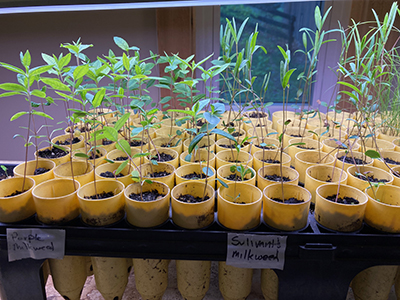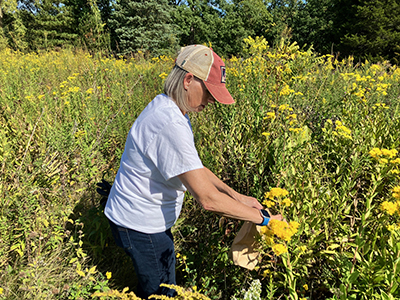Autumn is a time for harvest. Corn and soybeans are all being plucked from the fields by huge machinery that transforms seed-picking to an industrial scale. Hundreds of bushels per acre are making their way from field to silo. Simple seeds grown in the United States become worth more than $1.5 trillion on the U.S. commodities market. Our economy relies on seeds.
On a bright sunny September day, I find myself seeking seeds. Not for crops or food, but seeds of hope for the future. If you want to restore natural areas, you must depend on seeds. Vast prairies once covered the Illinois landscape. Bit by bit, those prairies were converted by agriculture. In a period of a couple of hundred years, our vast prairies were replaced by fields of crop seeds. Of Illinois’ original 21 million acres of prairie, less that .01% is estimated to remain. If we hope to save the prairie for future generations, we must become familiar with the plants, their seeds, and how to propagate them. Beyond the environmental benefits of restoring prairies, there is significant cultural significance.

Seedlings of both Purple Milkweed and Sullivant’s Milkweed started from local seed sources are ready for transplant.
MIKE MILLER
Seeds have always been valued by humans. It is estimated that our species have been actively planting seeds for food for tens of thousands of years. We really became efficient at agriculture some 12,000 years ago. But even before that, we surely harvested seed found in the natural world.
Seeds provide hope. West African ancestral grandmothers braided seeds into the hair of young people before they were brutally taken across the Atlantic as slaves. Hope that someday they would have an opportunity to grow their food. Okra, melon, rice, and other crops made this journey. A last gift from the elders to the youth, promising hope for a future in such brutality.
Humans and prairies existed in Illinois since the most recent retreat of glaciers 12,000 years ago. The unique mix of prairies, woodlands and savannas was the chief influencing factor for indigenous peoples. Their culture and survival depended on their knowledge of the plants and animals that inhabited the land. Their longevity on the landscape allowed them to develop methods of boosting food availability by growing edible plants from seed. Maize, legumes, and squash were eventually brought into North America through extensive trade routs that extended all the way to Central America and beyond. Their ability to grow these foods depended on the rich soils of the prairie.
Our modern culture is no different. We still grow corn and soybeans in the ancient footprint of prairies, but we have done it at a scale that has all but eliminated the prairie. Here and there, small postage-stamp sized remnants of prairie remain. They are the “arks” in which the seeds of hundreds of ancient species drift upon an ocean of monoculture. These seeds are crucial to restoring prairies so that they can once again bring diversity back to a fragmented landscape.
As I help harvest prairie seeds at the Tawny Oaks Prairie, I ask myself, “Why do I do this?”
There are many answers. It makes ecological sense to preserve examples of sustainable landscapes. Propagating rare plants keeps them from becoming extinct. But the answer that keeps me seeking seeds is, “that it is the right thing to do.” We have many impacts on our environment. Let’s make sure that some of our impacts are positive ones.
To take part in a seed collection workday, and learn how we use them in prairie restorations, join me at the Peoria Park District’s Tawny Oaks Field Station at 10 a.m. on the Thursday of Oct. 10 and 24, and 10 a.m. the Saturdays of Oct. 12 and 26. To register for these volunteer opportunities, and to find out more, visit the volunteer event page



1 comment for “Nature Rambles: Seeds of hope help our prairies”
Recent Comments
Great article Mike!!